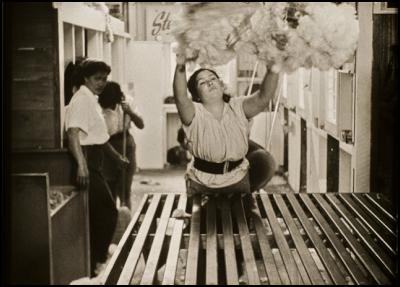Reel Life in Rural New Zealand
FOR IMMEDIATE
RELEASE
Reel Life
in Rural New Zealand
Agriculture, history and incredible inventions from the Hawke’s Bay, Tararua and Wairarapa regions will be showcased in all their cinematic glory next month, when the New Zealand Film Archive and New Zealand Historic Places Trust partner to present a programme of films that spans the 20th century. The films will be screened in five NZHPT registered heritage woolsheds.
Local history will come to life again in the historic woolsheds, through a selection of films from the Film Archive vaults. The 75 minute programme pays tribute to the rich and diverse heritage of the region, encompassing farming history, shearing gangs, kiwi inventions dating back to 1913, and some of the unique rituals of country life.
Curated by Jane Paul (Manager Outreach Services, NZFA) and presented in NZHPT registered historic woolsheds courtesy of the landowners, the screenings will give the public an opportunity to see some of their local history in some extraordinary woolsheds. For example, the Opening Night will take place in the Maraekakaho Woolshed attic. Maraekakaho Woolshed was a community hub during decades past – locals may remember it as a venue for dances. A local historian will be at each venue to discuss the area’s heritage and recent restoration projects.
NZHPT Central Region Area Coordinator David Watt says the partnership with the Film Archive made perfect sense. “These woolsheds are extraordinary in themselves, but film adds a new layer of storytelling that helps bring to life this region’s remarkable agricultural heritage,” he says.
"This is a wonderful opportunity to bring people close to their history – in this case, the development of our wool and agricultural industries. The films and the venues they are shown in are a vivid reminder of how the woolshed has been at the centre of shaping New Zealand’s unique way of life and character. Each of the chosen woolsheds are landmarks in their respective areas, and we are delighted they will be central to telling these stories to our communities."
The distinctive characteristics of New Zealand’s buildings are important to the way we shape our communities; socially, economically, aesthetically and culturally. The New Zealand Historic Places Trust conservation of this heritage enables New Zealanders to develop a greater understanding of history and identity.
The New Zealand Film Archive draws on items from their collection for regular screenings in the cinema and gallery at their Wellington head office. As part of their commitment to reaching audiences screenings are also held regularly around New Zealand as part of the Travelling Film Show.
The Reel Life in Rural New Zealand programme is a compilation of 20 short films, showcasing stories from Hawke’s Bay to Wairarapa. These include Broad Acres: A New Zealand Sheep Station (1940), a dramatised documentary centring around city girl who visits a family of Hawke’s Bay sheep farmers, as well as newsreel and documentary footage showing returned servicemen being trained as farmers near Masterton in 1945, the Puketapu Valley Settlers in 1952, and farming families living in Tinui in 1947 and Te Maire in 1960.
The famous topiary garden at Neuman, near Eketahuna, also features. Created by farmer John Cooper, the garden was a popular destination for tourists in the 1930s, who came to see couches, animals, a pianist playing the piano, and many more impressive topiary works.
It is hoped that shearers will come along and see the items on shearing in the 1950s, such as a film of the 1961 Golden Shears, which features Godfrey and Ivan Bowen.
Other films showcase inventions for the farm and home. Among these are the new 1953 master comb, the first electric tractor and the Wenham’s Outlaw pushmower (which could cut through 4” bolts without problem). Percy Fisher’s monoplane is documented lifting off (momentarily) into the Wairarapa sky in 1913, and MacEwan’s “flying banana” pump cleans the cowshed and gives joyrides to the kids.
Crafted with classic New Zealand ingenuity, in the No.8 fencing wire tradition, these films are presented along with an inventive recorded soundtrack composed and performed by Wellington musician Bill Hickman and friends.
Details for this film and architecture tour
are as follows:
Entrance to all screenings (except opening night) $5, door sales only.
FRIDAY 15 MARCH, OPENING NIGHT
- MARAEKAKAHO
Maraekakaho Woolshed attic, SH
50
Pre-film drinks from 6.30pm, film screening 7.30pm,
followed by supper organised by the Maraekakaho
community.
Tickets $20 (available from the Maraekakaho
school, or email janepaul@nzfa.org.nz)
SATURDAY 16
MARCH - MARAEKAKAHO
Maraekakaho Woolshed, SH 50
Open
Day 1pm - 6pm
Screenings 2pm, 4pm and 7.30pm
SUNDAY 17
MARCH - ARAMOANA
Aramoana Woolshed, 80 Shoal Beach
Rd
6pm
TUESDAY 19 MARCH - GREYTOWN
Elm Grove
Woolshed, 48 Kempton’s Line
5.30pm and
7.30pm
WEDNESDAY 20 MARCH - GREYTOWN
Elm Grove
Woolshed, 48 Kempton’s Line
2pm and 7.30pm
SATURDAY
23 MARCH - AKITIO
Moanaroa, 3179 Coast Rd
Open
Woolshed 2pm - 6pm
SATURDAY 23 MARCH - AKITIO
Akitio
Station Woolshed, River Rd
Screening 7pm
SUNDAY 24
MARCH - TINUI
Annedale Station Woolshed, Annedale Rd,
rapid no.1543
7.30pm

Credit: Pacific Magazine 9 (1955).
ENDS


 NZ Principals Federation: Principals Describe Budget As Bitter Sweet
NZ Principals Federation: Principals Describe Budget As Bitter Sweet GfK Radio: Radio Listening Tops 3.5M Weekly Listeners
GfK Radio: Radio Listening Tops 3.5M Weekly Listeners  Jacob Douglas Motorsport: Douglas Heads To The Oval After Breakthrough Victory
Jacob Douglas Motorsport: Douglas Heads To The Oval After Breakthrough Victory Research For Maori Health and Development: Bridging The Gap In HIV Prevention For Māori - Insights And Resources Now Available
Research For Maori Health and Development: Bridging The Gap In HIV Prevention For Māori - Insights And Resources Now Available Tertiary Education Union: Weltec And Whitireia Cuts A Shocking Blow For Their Communities
Tertiary Education Union: Weltec And Whitireia Cuts A Shocking Blow For Their Communities PHARMAC: Pharmac Proposes To Fully Fund Nutrition Replacements For Some People With Crohn’s Disease
PHARMAC: Pharmac Proposes To Fully Fund Nutrition Replacements For Some People With Crohn’s Disease